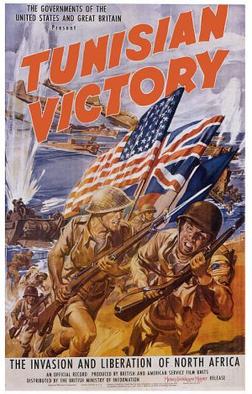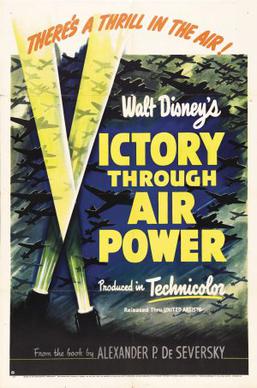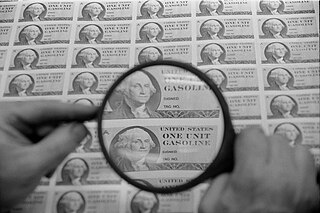External links
- The short film Highballing to Victory is available for free viewing and download at the Internet Archive .
| Highballing to Victory | |
|---|---|
| Produced by | Army Signal Corps |
Release date |
|
Running time | 11 minutes |
| Country | United States |
| Language | English |
Highballing to Victory is a short US propaganda film made toward the end of World War II about the importance of material and transportation in the war effort.
After some stylized, art deco, opening credits, the film begins with a shot of Hitler and scenes from Nazi rallies and early conquests in Europe. "In 1940 Germany set out to dominate Europe" the narrator begins. "He look upon the Eiffel Tower, and beyond it, to the Statue of Liberty." Then the scene switches to scenes in Paris soon after its liberation. "But in 1944 this happened to him." the film then goes on to explain the revolution in military logistics needed to create the Red Ball Express, a system of roadways leading all the way back to Normandy.
In quick succession the film explains how American transportation equipment, especially tires, can be used at that very moment in France, Italy, and in Russia to defeat the third Reich. The narrator reminds us that these materiel begins in America, and even the large amounts of tires and trucks created last year can be "casualties" of war already. The film also emphasizes that it is difficult even to get the materiel to the front, first having to get to port by rail, and then overseas in U-boat inhabited waters. Extensive time is spent on the transportation of materiel to China, and the difficulties getting it to Asia and over the "Hump".

The New Spirit is a 1942 American animated short film produced by Walt Disney Productions and the U.S. Department of the Treasury, and released by the War Activities Committee of the Motion Pictures Industry. The cartoon, which stars Donald Duck, was the first film created as part of Walt Disney's World War II propaganda production. It was commissioned by Henry Morgenthau Jr., then Secretary of the Treasury, to encourage American citizens to pay their income tax in support of the war effort. The film was directed by Wilfred Jackson and Ben Sharpsteen, and features Clarence Nash as the voice of Donald, Fred Shields as the radio announcer, and Cliff Edwards singing the theme song.

Tunisian Victory is a 1944 Anglo-American propaganda film about the victories in the North Africa Campaign.

Target-Invisible is a 1945 documentary short film produced by the First Motion Picture Unit after World War II. The film depicts the uses of radar in aerial direction-finding and precision high-level bombing by the United States Army Air Forces during World War II.

Wings for this Man is a propaganda film produced in 1945 by the U.S. Army Air Forces First Motion Picture Unit about the Tuskegee Airmen, the first unit of African-American pilots in the US military formed during World War II.
The Price of Rendova is a 1944 propaganda film created by the US Army Signal Corps. It documents the Landings on Rendova and Munda in the Solomon Islands.

December 7th is a 1943 propaganda documentary film produced by the US Navy and directed by Gregg Toland and John Ford, about the December 7, 1941 attack on Pearl Harbor, the event which sparked the Pacific War and American involvement in World War II. Toland was also the film's cinematographer and co-writer. The original version of this film, with a running time of 82 minutes, was not released but was retained by the National Archives. An edited version of 32 minutes length, which removed a long introductory segment and a shorter epilogue, was given limited release to specific audiences but won the Academy Award for Best Documentary in 1944. This is the only film Toland ever worked on for which he received a director credit.

Gracias Amigos was a 1944 propaganda short produced by the Office of the Coordinator of Inter-American Affairs to educate the American public about the contributions of Latin America during World War II.

The Battle of Britain was the fourth of Frank Capra's Why We Fight series of seven propaganda films, which made the case for fighting and winning the Second World War. It was released in 1943 and concentrated on the German bombardment of the United Kingdom in anticipation of Operation Sea Lion, the planned German invasion.
What Makes a Battle was a propaganda short produced by the US Army Pictorial Service in 1944. It documents the taking of the Marshall Islands while also encouraging increased war production.
It's Everybody's War is a dramatic propaganda short film produced by 20th Century Fox and distributed by the Office of War Information in 1942.

During American involvement in World War II (1941–45), propaganda was used to increase support for the war and commitment to an Allied victory. Using a vast array of media, propagandists instigated hatred for the enemy and support for America's allies, urged greater public effort for war production and victory gardens, persuaded people to save some of their material so that more material could be used for the war effort, and sold war bonds.
The third wave of Walt Disney Treasures was released on May 18, 2004. It was originally planned to be released in December 2003, but was delayed for almost half a year in order to meet an increased demand with a higher number of tins produced. This wave was the first to have a certificate of authenticity with the individual number of the tin on it, replacing the number embossed on the tin. This was the final wave released with side straps.

Britain re-created the World War I Ministry of Information for the duration of World War II to generate propaganda to influence the population towards support for the war effort. A wide range of media was employed aimed at local and overseas audiences. Traditional forms such as newspapers and posters were joined by new media including cinema (film), newsreels and radio. A wide range of themes were addressed, fostering hostility to the enemy, support for allies, and specific pro war projects such as conserving metal and growing vegetables.
Between 1941 and 1945, during World War II, Walt Disney was involved in the production of propaganda films for the U.S. government. The widespread familiarity of Disney's productions benefited the U.S. government in producing pro-American war propaganda in an effort to increase support for the war.

The Fight for the Sky is a short propaganda film commissioned by the US government to highlight the victories of the Allied air forces over Europe prior to the Normandy invasion.
London Can Take It! is a short British propaganda film from 1940, which shows the effects of eighteen hours of the German blitz on London and its people. Intended to sway the US population in favour of Britain's plight, it was produced by the GPO Film Unit for the British Ministry of Information and distributed throughout the United States by Warner Bros. The film was directed by Humphrey Jennings and Harry Watt, and narrated by US journalist and war correspondent Quentin Reynolds.

Victory Through Air Power is an American animated documentary propaganda film produced by Walt Disney Productions and released by United Artists on July 17, 1943. It is based on the 1942 book Victory Through Air Power by Alexander P. de Seversky. De Seversky appeared in the film, an unusual departure from the Disney animated feature films of the time.
World War II changed the possibilities for animation. Prior to the war, animation was mostly seen as a form of family entertainment. The attack on Pearl Harbor was a turning point in its utility. On December 8, 1941, the United States Army began working with Walt Disney at his studio, stationing Military personnel there for the duration of the war. The Army and Disney set about making various types of films for several different audiences. Most films meant for the public included some type of propaganda, while films for the troops included training and education about a given topic.

Rationing is the controlled distribution of scarce resources, goods, or services, or an artificial restriction of demand. Rationing controls the size of the ration, which is one person's allotted portion of the resources being distributed on a particular day or at a particular time.
Food Will Win the War is an American short animated film produced by Walt Disney Studios and released on July 21, 1942, seven months and two weeks after the December 7, 1941 attack on Pearl Harbor. The 6-minute short was one of a series of animated films produced by Disney during the war as part of a propaganda campaign. The animation was produced on order of the Department of Agriculture, first and foremost to educate about the importance of American agriculture in the war effort and also, to offset fears and panic of Americans who thought too many supplies were being sent overseas. The film was a morale boosting production, in the hope of improving public mood and opinion about sacrifice for the war effort.